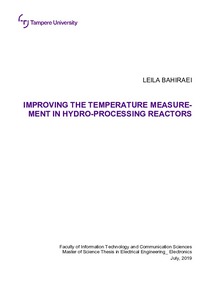Improving the temperature measurement in hydro-processing reactors
Bahiraei, Leila (2019)
Bahiraei, Leila
2019
Sähkötekniikan DI-ohjelma - Degree Programme in Electrical Engineering
Informaatioteknologian ja viestinnän tiedekunta - Faculty of Information Technology and Communication Sciences
This publication is copyrighted. You may download, display and print it for Your own personal use. Commercial use is prohibited.
Hyväksymispäivämäärä
2019-09-25
Julkaisun pysyvä osoite on
https://urn.fi/URN:NBN:fi:tuni-201908122864
https://urn.fi/URN:NBN:fi:tuni-201908122864
Tiivistelmä
The world is going to replace renewable and green fuels with fossil fuels to reduce the environmental issues and global warming effects. Bio-based feedstock is a biological source to produce fuel and considered as an alternative that can supersede fossil-based resources in the future. Co-processing is a transition towards green fuel which through a mixture of fossil and bio-based feedstocks are processed.
In co-processing, the biomass is blended with fossil-based feed and upgraded through hydro-treating in a catalytic reactor. Since biomass contains high amount of oxygen, the process is highly exothermic releasing heat and causing temperature rise inside the reactor. Hence, reactor temperature needs to be monitored properly to prevent serious accident and retain the required quality of the product. In petro-refineries, use of temperature measurement systems is a need and usually problematic in hydro-processing reactors. When introducing alternative or biomass feedstocks to the process, the problem will be more highlighted due to new reactants and different reactions.
The following work has expounded the need for measuring temperature in exothermic reactions. Reactions and products, main hardware and equipment has been described to express the need for temperature monitoring systems.
This thesis has considered different approaches and methods in measuring the temperature in reactors mentioning their advantages and disadvantages. Challenges stemmed from the new reactants and new reactions by introducing bio-based feedstocks were identified.
The material selection is crucial as almost all available temperature measurement systems has direct contact with the reactants and catalyst. Some widely-used materials in oil and gas industry were compared to choose the proper one for the application. The possible solutions reducing the problematic issues were recommended for design, procurement and installation of the temperature measurement system.
In co-processing, the biomass is blended with fossil-based feed and upgraded through hydro-treating in a catalytic reactor. Since biomass contains high amount of oxygen, the process is highly exothermic releasing heat and causing temperature rise inside the reactor. Hence, reactor temperature needs to be monitored properly to prevent serious accident and retain the required quality of the product. In petro-refineries, use of temperature measurement systems is a need and usually problematic in hydro-processing reactors. When introducing alternative or biomass feedstocks to the process, the problem will be more highlighted due to new reactants and different reactions.
The following work has expounded the need for measuring temperature in exothermic reactions. Reactions and products, main hardware and equipment has been described to express the need for temperature monitoring systems.
This thesis has considered different approaches and methods in measuring the temperature in reactors mentioning their advantages and disadvantages. Challenges stemmed from the new reactants and new reactions by introducing bio-based feedstocks were identified.
The material selection is crucial as almost all available temperature measurement systems has direct contact with the reactants and catalyst. Some widely-used materials in oil and gas industry were compared to choose the proper one for the application. The possible solutions reducing the problematic issues were recommended for design, procurement and installation of the temperature measurement system.
